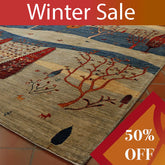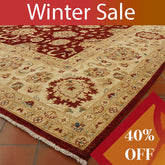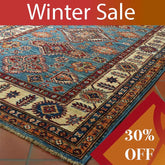Hand made Afghan Rugs and how they are finished
There is so much more to a 'Hand made Oriental Rug' than first meets the eye!
With the majority of our stock at Jennings Rugs coming from Afghanistan these days, I thought you might like to hear what is involved with the numerous finishing processes that the rugs have to go through. Whether it be traditional rugs or contemporary rugs, they all have to go through the same processes.
Despite all the troubles and upheaval in Afghanistan the ordinary people wish to get on with their lives and thankfully are still weaving rugs within their homes. For obvious reasons it is not safe for me to travel to Afghanistan, but when the rugs have been woven they are sent to Pakistan where they go through many different finishing processes and this is where I choose them.
1. This is a rug in the raw state from the loom, note the pile is exceptionally thick. The first process is the tumbling to knock out any dust, dirt, loose fibres etc. The rugs are loaded into a huge metal drum and they are tumbled for several hours.


2. The next stage is clipping the pile short which will bring out the definition of the pattern. It is amazing how much wool is sheared from the rug.


3. Stage 3 is the washing of the rugs, multiple times, using gallons of water, soap and some times herbs in the wash to soften the colours. The soap not only cleans the rugs but also softens the wool. A series of scrapers and brushes are used multiple times and with some force to remove any dirt or excess dye.


4. After washing the rugs are stretched out and nailed on raised planks to dry in the sunshine. The intense sun helps to develop a wonderful sheen on the wool.


5. Sometimes the pattern may run off course and needs to be corrected by an alignment process.

6. Next the rugs need to have rogue knots of white cotton cut out from the pile.

7. The rugs are brushed and combed to remove excess fluff from the pile.

8. If the selvedges are not woven at the time of weaving the rug, then they are sometimes stitched on afterwards.

9. The fringes need to be finished and cut level. Sometimes they can be plated or put in bunches with coloured windings around them.

10. Finally on a rare occasion some rugs might get damaged whilst going through these processes and so sometimes a repair or reweave is nessesary.

From start to finish these rugs and carpets go on such a journey before they have even arrived in the UK.
I hope that you found this interesting.










Leave a comment
Please note, comments need to be approved before they are published.